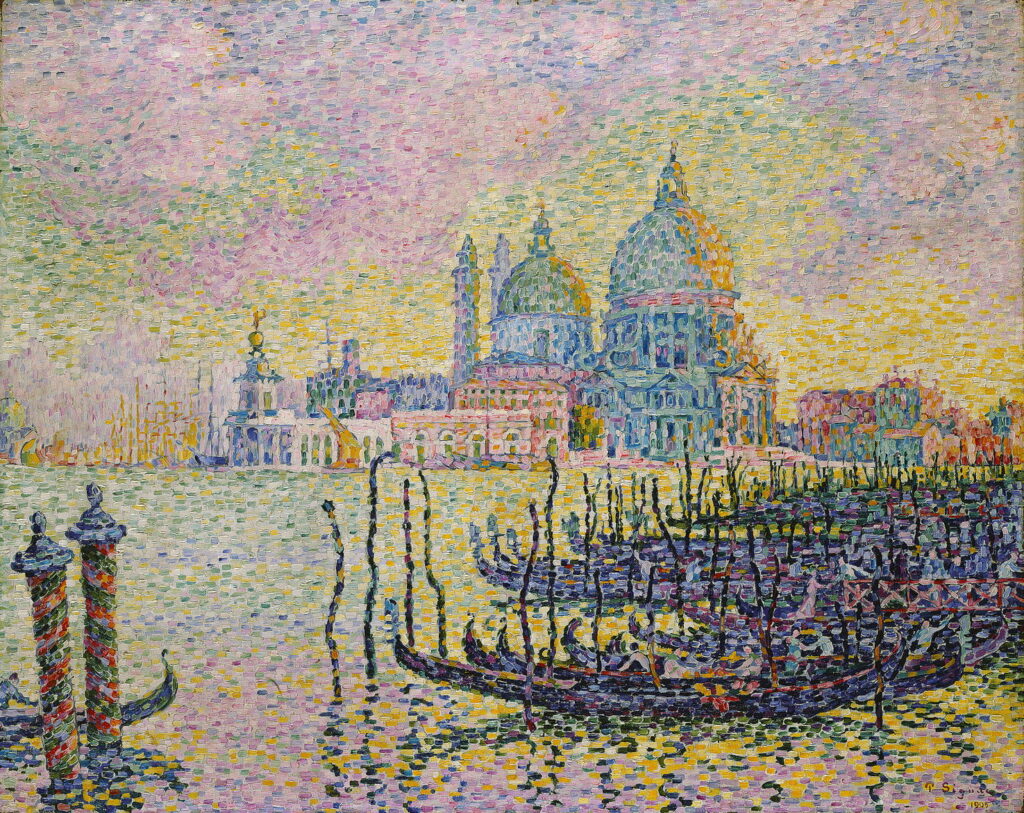Canals of Venice 1903-1910

In the early years of the twentieth century, the city of Venice grew in importance as a centre of art, with the Venice Biennale increasingly encouraging contemporary styles. That drew a succession of Post-Impressionists to depict the city and its famous canals.
Henri-Edmond Cross (1856–1910), Venice – The Giudecca (1903), watercolour, graphite, and charcoal on heavy, white wove paper, 17.1 x 24.8 cm, Metropolitan Museum of Art, New York City, NY. Wikimedia Commons.
Henri-Edmond Cross’s watercolour sketch of Venice – The Giudecca from 1903 is similar in approach to those painted by Paul Signac before he viewed Paul Cézanne’s late watercolours in 1908.
Henri-Edmond Cross (1856–1910), Regatta in Venice (1903-04), oil on canvas, 73.7 x 92.7 cm, Museum of Fine Arts, Houston, TX. Wikimedia Commons.
Cross’s Regatta in Venice from 1903-04 is a finished Pointillist painting in oils, bearing a strong similarity to those painted at this time by Paul Signac. In the middle distance there appears to be a race taking place.
Paul Signac (1863-1935), Mouillage de la Giudecca (Giudecca Anchorage, S. Maria della Salute) (Cachin 411) (1904), oil on canvas, 73.5 x 92.5 cm, Neue Pinakothek, Munich, Germany. Image by Ad Meskens, via Wikimedia Commons.
Paul Signac’s fascination with Venice had been inspired by the writings of John Ruskin, in particular The Stones of Venice. In the course of the early years of the twentieth century, he turned his large collection of studies made in front of the motif into a succession of major Neo-Impressionist oil paintings. Among the first, which he completed in 1904, was this view of the Giudecca Anchorage showing the church of Santa Maria della Salute. This set the compositional approach for many of his views of ports, with colourful vessels in the foreground, and lofty buildings dissolving in the distance.
Paul Signac (1863-1935), The Lagoon. Yellow Sail (Cachin 413) (1904), oil on canvas, 73 x 92 cm, Musée des Beaux-Arts et d’Archéologie, Besançon, France. Wikimedia Commons.
Another example from 1904 is Signac’s painting of The Lagoon. Yellow Sail with its rhythmic reflections.
Paul Signac (1863-1935), The Green Sail (Cachin 414) (1904), oil on canvas, 65 x 81 cm, Musée d’Orsay, Paris. Image by Sailko, via Wikimedia Commons.
Signac’s The Green Sail (1904) features the church of San Giorgio in the distance.
John Singer Sargent (1856-1925), Unloading Boats in Venice (1904), watercolour on paper, 25.4 x 35.3 cm, Private collection. WikiArt.
Meanwhile, John Singer Sargent found more unusual views of activities and parts of the city not normally seen by the visitor. This watercolour from 1904 shows Unloading Boats in Venice in the city’s port.
Paul Signac (1863-1935), Basin of San Marco, Venice (Cachin 415) (1905), oil on canvas, 129.5 x 162.6 cm, Chrysler Museum of Art, Norfolk, VA. Wikimedia Commons.
Basin of San Marco, Venice, completed by Signac in 1905, is one of the largest of his paintings of ports. This shows, at the left, San Giorgio Maggiore, in the centre Santa Maria della Salute, and to the right the Doges’ Palace and the Campanile of Piazza San Marco. In the foreground is a flotilla of bragozzi with their colourful sails. Signac’s preparations for this had been careful if not painstaking. They led from his watercolour sketches to a squared drawing with formal geometry and a planned colour scheme, which he then enlarged onto the canvas. He was clearly pleased with the result, and this work was featured in many of his subsequent major exhibitions.
Paul Signac (1863-1935), Entrance to the Grand Canal, Venice (Cachin 424) (1905), oil on canvas, 73.5 x 92.1 cm, Toledo Museum of Art, Toledo, OH. Wikimedia Commons.
My favourite among Signac’s views of Venice is his Entrance to the Grand Canal, Venice (1905). Its foreground is dominated by a shimmering and jumbled parade of gondolas, and melting into the distance is the towering silhouette of Santa Maria della Salute.
John Singer Sargent (1856-1925), Grand Canal, Venice (1907), watercolour on paper, 40.6 x 45.4 cm, The National Gallery of Art, Washingon, DC. WikiArt.
Sargent’s bravura watercolour sketch Grand Canal, Venice (1907) gives an idea as to his approach and style. It’s composed of a sparse collection of brushstrokes of watercolour which assemble into a detailed view. He sees Venice from the level of a gondola, the bows of which are also shown. His palette for these sketches is generally centred on earth colours for the buildings, with blue for the sky, water, and usually the shadows too.
Ivan Trush (1869–1941), Venice, San Giorgio Maggiore (1908), oil on canvas, dimensions and location not known. Wikimedia Commons.
In 1908, Ivan Trush visited northern Italy, where he painted this famous view of Venice, San Giorgio Maggiore. One of the smaller islands there, it has been painted extensively, perhaps most famously in Claude Monet’s late series. The church and its high campanile are prominent landmarks whose detail Trush has captured in this impressive oil sketch.
Paul Signac (1863-1935), Venice. Customs House (Cachin 470) (1908), oil on canvas, 65 x 81 cm, Private collection. Wikimedia Commons.
Signac painted Venice. Customs House in 1908, following a return visit to the city. This reverses his previous compositions by placing the Customs House in the mid-ground, with masts and sails behind. This loses the depth and grandeur of those earlier works.
Martín Rico y Ortega (1833–1908), Near the Grand Canal, Venice (1908), oil on canvas, dimensions not known, Currier Museum of Art, Manchester, NH. Image by Daderot, via Wikimedia Commons.
Martín Rico maintained his summer visits to Venice right up to the year of his death, when he painted this unusual view Near the Grand Canal, Venice (1908). A person is in the water beside the gondola, and the boatman is assisting them with a boathook while the other occupants seem quite detached from what is going on.
John Singer Sargent (1856-1925), Rio dei Mendicanti, Venice (c 1909), watercolour and pencil on off-white paper, dimensions not known, Indianapolis Museum of Art, Indianapolis, IN. Wikimedia Commons.
Sargent’s watercolours were by no means dependent on the sophistication of his technique: Rio dei Mendicanti, Venice from about 1909 works its magic almost entirely from a combination of wet on dry and wet on wet. There isn’t even much in the way of a graphite drawing under its thin washes.
Although the rise of Modernism brought fewer painters to the canals of Venice, they increasingly flocked to the Venice Biennale during the twentieth century, and Venice remains a focus of art.


